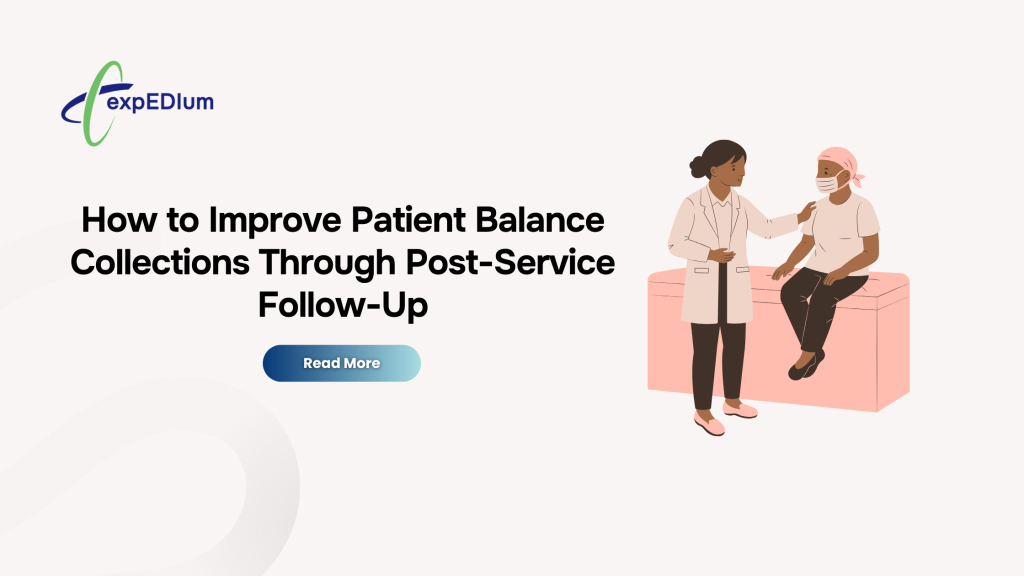Have you ever wondered why a significant portion of your practice’s revenue seems to vanish after services are delivered? Many practices deliver excellent care, but when it comes to collecting the patient’s share of the bill, gaps in post-service follow-up can lead to delayed payments, confusion, and rising bad debt. For multi-specialty practices, improving patient balance collections is no longer optional—it’s a necessity for sustainable growth.
The challenge: Patient responsibility is growing
High-deductible health plans and complex insurance policies have shifted a large portion of the financial responsibility to patients. According to industry research, nearly 58% of write-offs in 2022 were due to unpaid patient balances. The consequences are clear: unpaid balances lead to cash flow disruptions and increased administrative workload for your revenue cycle team.
Patients often leave the clinic unaware of their exact financial responsibility. Confusing bills, multiple statements from different specialties, and delayed communication increase the likelihood that patients either ignore payments or defer them indefinitely. The result? Patient balance collections lag, and your revenue suffers.
Key strategies to improve collections
- Transparent communication upfront
One of the most effective ways to improve patient balance collections is by clearly communicating their responsibility before or immediately after service. This includes co-pays, deductibles, coinsurance, and any non-covered services. Studies show that 71% of patients are confused by their medical bills (source). Providing clear, itemized estimates reduces confusion and encourages timely payments. - Timely post-service follow-up
The longer a balance goes uncollected, the less likely a patient is to pay. Research shows that patient engagement declines significantly after the first 60 days. Implementing automated reminders through emails, SMS, or patient portals can drastically improve collection rates by keeping balances top-of-mind. - Personalized messaging
Generic statements often go unnoticed. Personalized communication—addressing patients by name and referencing the specific service—has been proven to improve payment rates. Tailoring your approach shows care and builds trust, increasing the likelihood that patients will respond promptly. - Flexible payment options
Offering installment plans or online payment portals allows patients to pay their balances conveniently. The easier it is for patients to pay, the faster collections occur. Providing multiple channels for payment—credit card, ACH, online portal, or over the phone—caters to different patient preferences. - Monitoring and metrics
Track key metrics such as days in accounts receivable (A/R), patient collection rate, and bad debt percentage. Monitoring these metrics allows your practice to identify bottlenecks and adjust follow-up strategies accordingly.
Benefits of a proactive follow-up approach
- Improved cash flow: Faster collections reduce reliance on insurance reimbursements and minimize bad debt write-offs.
- Enhanced patient experience: Clear communication about financial responsibility reduces confusion and builds trust.
- Operational efficiency: Automation and clear workflows reduce the administrative burden on staff.
Steps to implement a post-service follow-up workflow
- Map current follow-up process: Identify who contacts patients, when, and how often.
- Define goals: Example—reduce outstanding patient balances over 60 days by 20% in six months.
- Implement automation: E-statements, SMS reminders, portal notifications.
- Train staff: Ensure all patient-facing employees communicate empathetically and clearly about balances.
- Introduce self-service options: Online payment, payment plans, credit card on file.
- Monitor and adjust: Track collection rates, contact success, and write-offs, refining strategies based on data.
Conclusion
Post-service follow-up is not just a billing task—it’s a strategic lever that can significantly improve patient balance collections, reduce bad debt, and enhance patient satisfaction. Multi-specialty practices that adopt transparent communication, timely engagement, and flexible payment options will not only improve cash flow but also strengthen the patient-provider relationship. If your practice is ready to optimize patient balance collections, expEDIum can help streamline workflows and provide tools to make collections smoother, faster, and more patient-friendly.
Suvarnna Babu is a B2B content marketer and Digital Marketer at expEDIum, where she specializes in writing healthcare tech blogs that simplify complex RCM and EHR concepts for providers and billing professionals. With a background in English Literature and hands-on experience in SEO, email marketing, and paid ads, she creates content strategies that align with business goals and resonate with real-world users.
